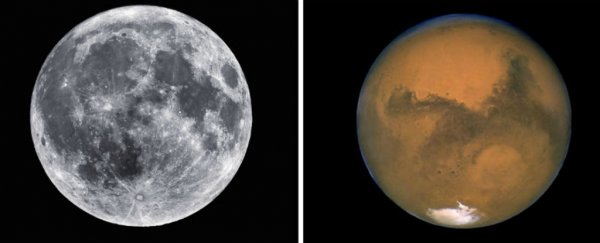Sometimes sky-watching is hard. Meteor showers can be spotty, and you need to spend hours out in the backyard, neck arched uncomfortably in the cold, in the hopes that you're in the right place at the right time to see a few bright sparks zooming by. Oops, here come the clouds.
Eclipses are awesome, but you've gotta get your time conversions right, hope that you're in the right hemisphere to see anything, and don't even get me started on all the precautions you should be taking if it's a solar eclipse.
Sometimes, all you want to do is just 'look up' and see something incredible. No telescopes, no 'right place right time', just your own damn eyes staring at the sky seeing a full blue moon pair up with a bright red Mars. Sound good? Well, you've got all weekend to catch this one.
On May 21 to 22, we'll not only get an 'extra' full moon of the season (don't worry, I'll come back to this), but it will be seen in the night sky with a more noticeably red Mars, making it a two-for-one opportunity for sky-watching.
First off, what is this 'extra' full moon, and why is it blue? I'm gonna let you down easy here and tell you that this type of blue moon isn't literally blue (I know, I know, we're sad too).
It is possible for the Moon to appear blue in the night sky, but this is an extremely rare occurrence, caused by dust particles in the atmosphere scattering light to make the Moon appear blue to us down here on Earth. When the Krakatoa volcano erupted in 1883, the dust it spewed out gave people around the world green and blue moons every night for as long as two years after the event.
The blue moon we're talking about is more to do with that old saying, "Once in a blue moon," as in, "This doesn't happen very often."
As Bruce McClure explains over at Earthsky.org, there are actually two definitions of a blue moon along these lines, and it gets a little complicated. Traditionally, a blue moon means the third full moon in season with four full moons - a season here is defined as the period of time between a solstice and an equinox - or vice versa.
Usually, we only get three full moons per season, so when we get an extra one, it's a rare occurrence - the May 21-22 blue moon is the first one since August 2013.
More recently, another definition of a blue moon has emerged - the second full moon in the same calendar month - but the 'fourth in a season' definition is rooted in history, so more likely to stick around as the 'true' definition of the term.
So what causes a seasonal or a monthly blue moon?
"In both instances, the blue moon is a calendar oddity caused by the 19-year Metonic cycle," says McClure. "There are 235 full moons in 19 calendar years, yet only 228 calendar months (or 76 three-month seasons). Therefore, it's inevitable that seven out of 19 years will feature two full moons in one calendar month. And it's also inevitable that seven out of 19 years will have four full moons in one season."
So that's why we're getting an extra full moon this weekend, why is Mars expected to be super bright and red at the same time? Mars will be in opposition on May 22, which means Earth will begin to pass between it and the Sun this weekend.
This happens every two years and 50 days, and we're just coming out of a non-opposition year, throughout which Mars has appeared relatively faint in the night sky.
Deborah Byrd explains for Earthsky.org:
"The brightness of Mars in our sky depends on where our two planets are in orbit around the sun. Sometimes Earth is close to Mars, and sometimes we are far away.
We are relatively close - and Mars appears at its brightest in our sky for that two-year period - every time Earth passes between the Sun and Mars. At this time, Mars appears at opposition - opposite the Sun in our sky - rising in the east when the Sun sets in the west."
In non-opposition years, Mars is farther away in the Solar System from Earth, and now we're finally going to see it in all its glory.
Oh and Mars will also be closer to Earth than it has been in a decade, so, you know, that's not something you want to miss!
There you have it - a sky-watching double whammy this weekend. The 21 May 2016 blue moon turns full at 21:14 Universal Time - that's May 21 at 17:14 EDT or May 22 at 7:14 AEST. It will be visible from everywhere on Earth.
Happy sky-watching!
